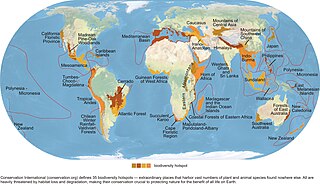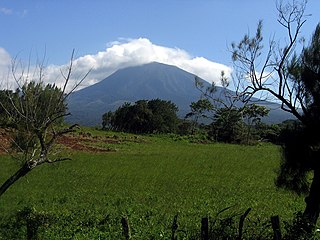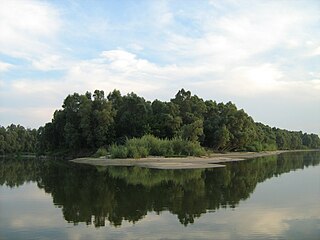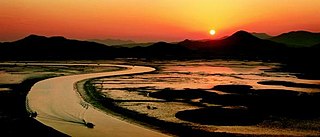
The Brisbane Water National Park is a protected national park in the Central Coast region of New South Wales, in eastern Australia. The 11,506-hectare (28,430-acre) national park is situated 70 kilometres (43 mi) north of Sydney, 10 kilometres (6.2 mi) west of Woy Woy, and 12 kilometres (7.5 mi) southwest of Gosford.
This is an index of conservation topics. It is an alphabetical index of articles relating to conservation biology and conservation of the natural environment.

A marsh is a wetland that is dominated by herbaceous rather than woody plant species. Marshes can often be found at the edges of lakes and streams, where they form a transition between the aquatic and terrestrial ecosystems. They are often dominated by grasses, rushes or reeds. If woody plants are present they tend to be low-growing shrubs, and the marsh is sometimes called a carr. This form of vegetation is what differentiates marshes from other types of wetland such as swamps, which are dominated by trees, and mires, which are wetlands that have accumulated deposits of acidic peat.

Habitat conservation is a management practice that seeks to conserve, protect and restore habitats and prevent species extinction, fragmentation or reduction in range. It is a priority of many groups that cannot be easily characterized in terms of any one ideology.

Vernal pools, also called vernal ponds or ephemeral pools, are seasonal pools of water that provide habitat for distinctive plants and animals. They are considered to be a distinctive type of wetland usually devoid of fish, and thus allow the safe development of natal amphibian and insect species unable to withstand competition or predation by fish. Certain tropical fish lineages have however adapted to this habitat specifically.

Habitat destruction is the process by which a natural habitat becomes incapable of supporting its native species. The organisms that previously inhabited the site are displaced or dead, thereby reducing biodiversity and species abundance. Habitat destruction is the leading cause of biodiversity loss. Fragmentation and loss of habitat have become one of the most important topics of research in ecology as they are major threats to the survival of endangered species.

Fire ecology is a scientific discipline concerned with natural processes involving fire in an ecosystem and the ecological effects, the interactions between fire and the abiotic and biotic components of an ecosystem, and the role as an ecosystem process. Many ecosystems, particularly prairie, savanna, chaparral and coniferous forests, have evolved with fire as an essential contributor to habitat vitality and renewal. Many plant species in fire-affected environments use fire to germinate, establish, or to reproduce. Wildfire suppression not only endangers these species, but also the animals that depend upon them.

Guanacaste Conservation Area is an administrative area which is managed by the Sistema Nacional de Areas de Conservacion (SINAC) of Costa Rica for conservation in the northwestern part of Costa Rica. It contains three national parks, as well as wildlife refuges and other nature reserves. The area contains the Area de Conservación Guanacaste World Heritage Site, which comprises four areas.

There are several types of protected areas of the Czech Republic. The main form of landscape protection is delimitation of special protected areas. All the types of protected areas are determined by law.

Gornje Podunavlje Special Nature Reserve is a large protected area of wetland in the northwest of Serbia, on the Danube's left bank. It comprises two large marshes, Monoštorski Rit and Apatinski Rit and vast forests, meadows, ponds, swamps and the Danube's meanders, including 66 km (41 mi) of the Danube course. It is a part of the trans-boundary biosphere reserve "Mura-Drava-Danube", a five country project, dubbed the "Amazon of Europe".

Suncheon Bay Ecological Park is a protected natural area near Suncheon, South Korea. It is a bay between Yeosu and Goheung peninsulas, located 8 km (5.0 mi) from the center of Suncheon, with 21.6 km2 (8.3 sq mi) of mudflats and 5.4 km2 (2.1 sq mi) of reed beds.

Gotjawal Forest is a naturally formed forest located on the middle slopes of Halla Mountain, Jeju Island in South Korea. It covers the rocky area of ʻaʻā on Jeju Island off the southwestern coast of South Korea. Due to the geographical feature, the region remains largely undisturbed by people. The Gotjawal Forest is an enclave of the Southern Korea evergreen forests ecoregion, and is a favorite place of the Jeju locals.

The Paroo-Darling National Park is a protected national park that is located in the Far West region of New South Wales, in eastern Australia. The 178,053-hectare (439,980-acre) national park spans two distinct regions in the outback area. This region covers the arid catchments of the Paroo River and the Paroo-Darling confluence to the south.
Moojechineup is a high moor located on Mt. Jeongjok in Ulsan, Korea. The name 'Mooje' came from a ritual praying for rain. Mooejechipneup has an area of 4 hectares, and it is composed of 4 swamps: first at 510m above sea level, second at 558m, and third and fourth at 630m. As a 6,000-year-old high moor, it is known to be the oldest high moor in Korea, and there are so many different fauna and flora species living at Moojechinuep. It was registered as a Ramsar Wetlands on December 20, 2007 and became the 7th Ramsar Wetlands in Korea.

The Yanga National Park is a newly formed national park, located near the township of Balranald in south- western New South Wales. It covers an area of 66,734 hectares which includes 1,932 hectares of Yanga Nature Reserve, and has a frontage of 170 kilometres (110 mi) on the Murrumbidgee River. It is largely located in the Lower Murrumbidgee Floodplain, which is included on A Directory of Important Wetlands in Australia because of its importance as a breeding site for waterbirds when flooded.

Dongbaekdongsan is located in the unique ‘Gotjawal’ forest in the Jeju-do province, South Korea. The Gotjawal forest in Jeju Island is the only region among the world where the tropical northern limit plants and polar southern limit plants coexist. Also, 'Gotjawal' has abundant groundwater and excellent effects of heat-retaining and rehydration. 'Dongbaek' and 'dongsan' mean 'camellia' and 'hill' respectively in Korean.

South Chilcotin Mountains Provincial Park is a provincial park in British Columbia, Canada, located on Highway 40 northwest of Lillooet, British Columbia. The park, which is 56,796 ha. in size, was established on April 18, 2001, and It was created out of a portion of the Spruce Lake Protected Area. The park is located on three Indigenous Nations: The Tsilhqot’in, St’at’imc, and Secwepemc.
Located in the southern part of British Columbia, Columbia National Wildlife Area was established to protect its wetlands and as a temporary home for migratory birds travelling to South America. The National Wildlife Area (NWA) is divided into four unit areas: Wilmer, Spillimacheen, Brisco and Harrogate, which are home to many diverse species of animals and plants which are significant in Canada.

South Korea, also known as Republic of Korea is a nation located in East Asia. It is a peninsula with 3 parts of its nation facing the sea; east, west and south. There are numerous wildlife existing in Korean Peninsula. The characteristics of the wild mammals in Korea is that despite South Korea's small territory, there are many medium and large sized animals. It is natural characteristic that medium and large sized animals require large land and vast amount of food to survive. The characteristic of fauna in South Korea follows the regional aspect that the nation is connected to the wider Eurasian continent, resulting, surviving mammals to also have continental elements.

Getbol are mudflats, or tidal flats, coastal sedimentary systems. They are important habitats for different types of organisms, including migrating birds and marine fauna such as clams, crabs, octopuses, and snails. In 2021, four getbol sites in South Korea were listed as a UNESCO World Heritage Site due to their outstanding natural properties. Each of these sites represent a different type of getbol.
















